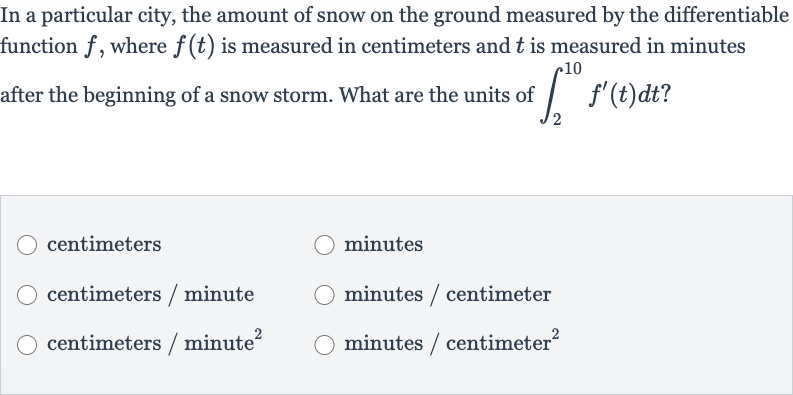AI tutor
Welcome to Bytelearn!
Let’s check out your problem:

In a particular city, the amount of snow on the ground measured by the differentiable function , where is measured in centimeters and is measured in minutes after the beginning of a snow storm. What are the units of ?centimetersminutescentimeters / minuteminutes / centimetercentimeters / minute minutes / centimeter
Full solution
Q. In a particular city, the amount of snow on the ground measured by the differentiable function , where is measured in centimeters and is measured in minutes after the beginning of a snow storm. What are the units of ?centimetersminutescentimeters / minuteminutes / centimetercentimeters / minute minutes / centimeter
- Rate of Change Interpretation: The integral of a rate of change (which is what represents, as the derivative of with respect to time) gives the net change over the interval. Since is measured in centimeters, and is measured in minutes, the derivative represents the rate of change of snow in centimeters per minute.
- Integration of Rate of Change: When we integrate with respect to over the interval from to minutes, we are essentially summing up the instantaneous rates of change (centimeters per minute) over the time interval (minutes). This will give us the total change in snow accumulation over that time period.
- Units of Integral: The units of the integral will be the product of the units of the derivative (centimeters per minute) and the units of the variable of integration (minutes). Multiplying these units together, the minutes will cancel out, leaving us with just centimeters.
- Conclusion: Therefore, the units of the integral are centimeters.
More problems from Solve quadratic equations: word problems
QuestionGet tutor help
QuestionGet tutor help
QuestionGet tutor help
QuestionGet tutor help
QuestionGet tutor help
QuestionGet tutor help
QuestionGet tutor help
QuestionGet tutor help
